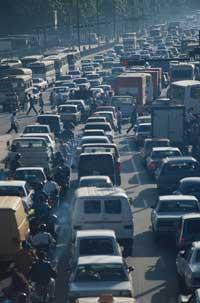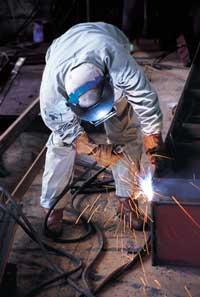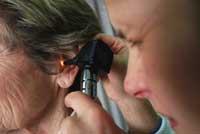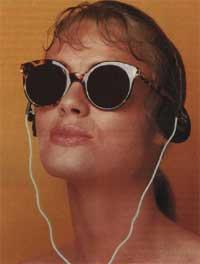Pollution that comes to our ears
2000/04/16 Carton Virto, Eider - Elhuyar Zientzia
The tubes of the cars in line, the truck that collects the garbage, the drill that is being used to repair the sidewalk, the plane that will land, the motorcycle that passes through the window, who has never suffered a small crisis for this type of noise? And the noise is not only the sound that we do not want to hear, but also the sound that hurts the human being. Hearing loss, high blood pressure, stress, sleep problems, difficulties in concentration and work and, in general, loss of quality of life and inability to stay relaxed are the main effects of noise in humans.
Although we do not see it, therefore, sound is a force that we notice well, and despite being a subjective limit between noise and sound, nowadays laws are necessary that regulate its intensity.
Numerous standards and few results

The European Commission presented in 1996 the Green Noise Book, in which it placed noise as one of the main environmental problems of the School. However, since then it has used less money and force than to fight against air pollution or water problems. In recent years the sources of noise pollution have been identified, but laws and regulations have been agreed and passed over the years: standards have been established for the control of noise generated by vehicles and work tools used on the street, such as mowers, and certificates and homologation procedures have been established that would demonstrate that the new products met the established noise limits. However, the measures adopted have had quite limited results, so the European Commission has wanted to further promote anti-noise initiatives by strengthening local solutions.
In the Spanish State the protection of people exposed to noise is less, since there is no specific legislation that regulates this source of pollution. Noise can be opposed by the regulation of annoying, unhealthy, harmful and dangerous activities, although the law allows a subjective interpretation of annoying or harmful words. However, in the 1990s, administrative laws have entered into force that regulate the noise generated by vehicles and/or the acoustic conditions that must be met by households. In the Autonomous Community of the Basque Country the fight against noise has also begun, since those who like to go out at night have realized that the new closing times of restaurants and bars are part of this fight. However, much remains to be done and not only by those with authority. In short, noise is a pollution that we all generate and especially everyone.
Physical and psychological effects
The effects of noise can be divided into three groups: physiological effects, such as hearing loss, ear pain or difficulty controlling the muscles; psychological effects, especially during sleep, that is, those that occur when noise does not allow interrupting or resting properly. Finally, noise can cause interference in communications with the environment. Try to talk to the neighbor that the plane is landing!

If we sometimes think we hear less or begin to whistle our ears, it can be a sign that we live in an excessive sound environment, which are the emergency notes sent by the ears. When leaving a nightclub where music is very high, we often perceive the two symptoms mentioned. To check for temporary hearing loss, however, a hearing test will be needed. However, and if you can't escape the noise, keep in mind the following advice: if you have to hear a sound of 100 decibels for two hours a day, in the next 22 hours it circulates in places with a sound less than 90 decibels to form the ear. Normally, lost hearing is recovered in 12 or 14 hours, although training and person times depend on the duration of the noise. But what is not recovered in that period is lost forever and these losses are added to the other.
Auditory buzz is a sign that the auditory organ does not work properly. People affected by the noise have to learn to live with this buzz, as doctors can do little against it. You don't have to hear what you want and don't want, that's the bad fate!
Noise usually damages the ear area where high-frequency sounds are processed, and people who suffer from definitive hearing loss have the following problems:
- They listen to someone speaking, but they are not able to understand the words.
- Difficulty identifying the sound source.
- If there is a lot of sound around the speakers, you will have difficulty distinguishing the voices of the speakers and cannot distinguish them, so you will not hear any. Group interviews become penances.
- Although it seems paradoxical, they tend to be more sensitive to the loudest sounds, that is, when you speak very low they do not hear, but if you talk too high, they tend to have greater drawbacks than normal people.

The psychological effects of noise pollution are more difficult to measure, but they exist. Depressions and nerves may be due to the fact that the ear is not able to adapt to noise, since, unlike the eyes, the ears do not have special mechanisms of adaptation to sound. Instead of adjusting the ear to sound, attitude is what you want to adapt to sound, but attitude and body often don't match. Therefore, even if the adopted attitude is able to withstand the noise, if the body is not able to do the same, unwanted frustrations can occur. And without going so far, sleep is the function that most prevents noise. Some cannot sleep because of noise or feel asleep. And those who sleep little have problems with nervousness, difficulty concentrating and ease of getting angry
... TABLES Sound intensity tables
Intensity (in decibels) | Example | Intensity (in decibels) | Bearable per day |
140 karaktere -> | Proximity siren noise (pain threshold) | Introduction | 8 hours |
Other | Emergent plane, amplified music | Information | 4 hours |
120 | Electric saw, snowmobiles | 100% | 2 hours |
100% | Tractor, farm equipment | 105 | 60 minutes |
Introduction | Injury threshold (hearing loss may occur from this level) | Results | 30 minutes |
Other | Sound-protected tractor cab interior | Results | 15 minutes or less |
| More information | Dishwasher, radio | ||
Introduction | Normal conversation | ||
Description | Leaf whisper, low music | ||
Services | Quietly interview | ||
Services | Lower hearing limit | ||
0. | Strict lower ear limit, weaker sounds |
Excessive noise in rural houses
Noise pollution is not only associated with large cities or traffic. In all professions that adversely affect hearing, rural house workers are the most hearing impaired, as tractors, harvesters, sharpeners, shotguns, conveyor belts, cereal dryers, etc. produce a high noise that, without control, can suffer permanent hearing loss.

The most common solution, when practical and economically viable, is the adaptation of machines that cushion the noise generated by the machines used in agriculture, attacking the noise source.
These measures, often simple, consist in the reduction of vibrations by the replacement of parts deteriorated or worn by the use; the reduction of noise caused by friction ensuring that the different parts of the machine are well oiled; the installation of silencers that control the noise produced by air currents in any equipment with motor; and if these measures are insufficient (and enough), the installation of means that protect the machine operator from the noise of the tractors. However, despite the attenuation of the noise generated by the tractors, other agricultural instruments that will lift the personnel (such as bleaching machines, cereal dryers or harvesters) remain to be conditioned, and if it was not possible to reduce the noise generated by these machines, the other solution would be to adjust the working hours. Devoting less hours to work with much noise, the ears of workers would suffer less damage. For example, a 95 decibel tractor can work for four hours. The last alternative is to use self-protection plugs. In this case the plugs that are squeezed against the ear are more suitable than those that are inserted in the ears, since they cushion the noise more and are cleaner.
Published in the supplement Natura de Gara

Gai honi buruzko eduki gehiago
Elhuyarrek garatutako teknologia





